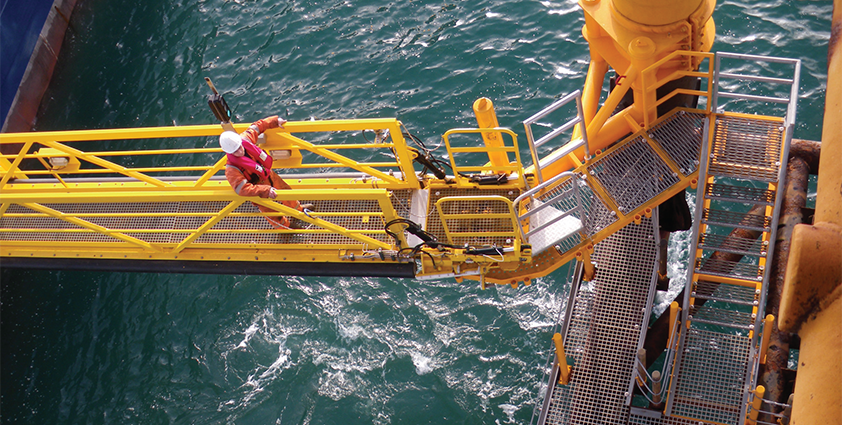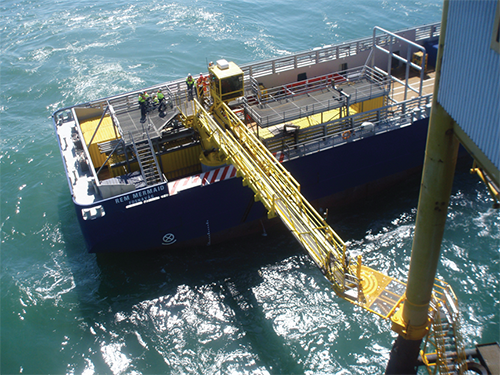
Offshore Solutions BV: Bridging Vessels and Installations Safely Since 2007
Bridging the gap
Although millions of offshore crew transfers take place each year, they remain one of the highest risk activities for personnel.
With access to offshore structures only possible by either air or sea, and environmental and climate concerns making helicopter and small vessel transfers less feasible, a safe and reliable alternative is sorely needed. Offshore Solutions BV was established in 2007 as a 50-50 joint venture between AMEC and Cofely Nederland, with the aim of providing safe access between vessels and offshore installations. Recognising the challenges of offshore transfers, Offshore Solutions has designed and implemented a groundbreaking new system – the Offshore Access System (OAS), which provides a safe, innovative and cost effective solution for undertaking construction, maintenance, and de-commissioning work on offshore structures, in both the oil and gas and wind energy industries.
The OAS is a patented heave-compensated walkway designed for use in the demanding conditions of the North Sea or any other similar global offshore environment. The system can be installed onboard any suitable DP2 vessel, whilst all that is required on the offshore structure is a vertical pole, small horizontal platform and access to deck level. The heave-compensation system, which maintains the end of the walkway at a constant height, is automatically enabled as the walkway is slewed outboard, and a constant force system ensures that pressure is exerted against the installation’s vertical pole.
Once secured by the latching system, the walkway is lowered onto the horizontal platform providing a robust connection once connected and the heave-compensation system is disengaged, allowing the walkway to ‘float’ between the vessel and installation. The OAS automatically compensates for the six movement planes of the vessel’s motion, thereby allowing the safe transfer of personnel.
“Oil and gas operators have been aware of the possibilities of not using helicopters – their usual method of shuttling personnel to and from unmanned installations – for some time. With our system, personnel live aboard the vessel in the field and then use the OAS to access the installation, which offers up to 10.5 hours operable man-hours each day, which is up to 70 per cent more than the six hours using helicopter shuttling. Our system has been operating for the past five years in the southern region of the North Sea, and for the past two years has operated in the harsher environment of the central North Sea,” explains Lindsay Young, managing director of Offshore Solutions.
John Cunningham, business development manager, continues: “Although we have been operating for five years, there is very little competition in the market for this type of technical solution. Since the business began, we have made over 6000 connections and transferred in excess of 70,000 personnel without any safety incidents at all.” This safety record is a key credit to the business, and theresult of a culmination of different features including a traffic light system to control personnel movement across the walkway, emergency fail-safe procedures, operator skill, and engineering of the system itself.
 The OAS is operated by a team of expert technicians who live alongside the crew of the operating vessel. Working together with the vessel’s captain, dynamic positioning operator and other key members of staff, these technicians ensure that a safe connection is carried out. At present Offshore Solutions has ten 20-metre OAS’s in the market – two of which have been sold to clients and the other eight offered to the wider market on a lease basis.
The OAS is operated by a team of expert technicians who live alongside the crew of the operating vessel. Working together with the vessel’s captain, dynamic positioning operator and other key members of staff, these technicians ensure that a safe connection is carried out. At present Offshore Solutions has ten 20-metre OAS’s in the market – two of which have been sold to clients and the other eight offered to the wider market on a lease basis.
Given the increasing demand that Offshore Solutions is experiencing for short-term hires, the company is developing two complimentary systems to the OAS to increase practicality of this service. “One of these modifications is to turn the access system into a freestanding unit, which means that it can be installed on a suitable DP2 vessel in under 24 hours. Previously it took several days to install it, which made leasing it out for short periods of time disproportionately expensive for the operator. We are aiming to launch this freestanding at the end of April. The second technical development is of a magnetic connection model, enabling us to clamp the OAS onto existing steelwork within the structure, without having to modify the installation prior to operations,” highlights John.
Although at present much of Offshore Solutions’ work has been within the North Sea, the company has also installed access systems for Equinox in Singapore, operated a system for Shell in the Philippines and has recently introduced its first system in Qatar for Qatar Shell GTL Ltd. John notes: “Shell in Qatar has just completed construction of one of the world’s largest gas to liquid plants. This is fed by two wellhead platforms offshore. Shell Qatar is utilising an OAS equipped vessel as its primary means of accessing those assets to carry out construction and maintenance work, and to provide a safe refuge in case of emergency. Following this success, several other major operators within the region have expressed interest in the OAS.”
Despite the multitude of opportunities available within the industry for the OAS, one of Offshore Solutions’ key challenges is to get the industry to implement this new technology on a wider scale. In support of this, it has carried out several visits with prospective clients to show the system in action at one of the company’s several long-term contracts. With Offshore Solutions also engaged with a number of vessel designers that are looking to integrate the OAS into the original design of a vessel, the commercial potential of the system appears to be well recognised within the market.
Given certain similarities between the oil and gas, and offshore wind farm industries transfer requirements, the renewable energies market is a logical sector for Offshore Solutions to move into. Offshore Solutions seems set to continue to raise the benchmark in the transfer of personnel offshore.
Lindsay concludes: “At the moment the emphasis is on fine-tuning the system and introducing the new freestanding and magnetic connection developments to the market. We are looking to have more units out in the market, both in the North Sea, and internationally. Ideally, we would like to have a fleet of the OAS available for short-term lease in key locations such as Singapore, Gulf of Mexico, and West Africa. This will enable us to quickly supply clients on a local basis wherever they are located, with the freestanding and magnetic connection models facilitating quick installation and operation.”
Offshore Solutions BV
Products: Offshore personnel access walkways